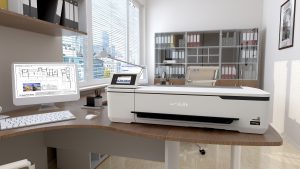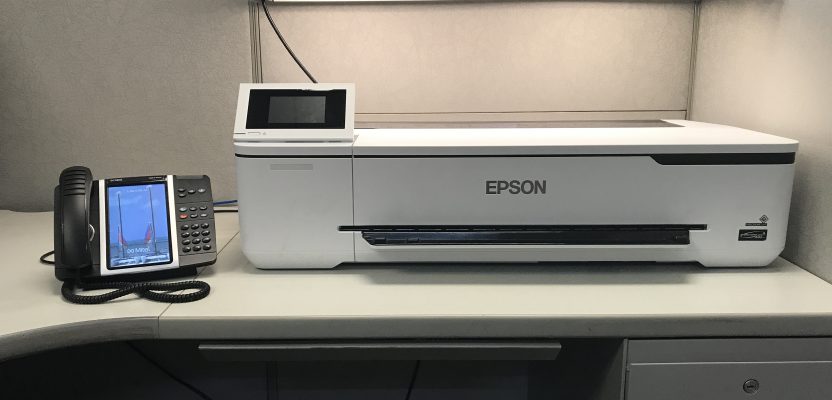A New Series of Large-format Plotters for Small Businesses and Home Offices
At the 2018 Esri User Conference and Exhibition, Epson announced a new line of T-Series large-format plotters that should appeal to small home/office needs for surveyors, engineers, architects, designers, and people working in schools and construction job shacks. Folks can plot out check plots and construction drawings on the spot; schools and businesses can also plot out banners and posters as needed. Entry-level plotters are a welcome addition.
Like a lot of folks, I’m agonizing over letting go of my legacy plotter. It keeps working, tirelessly plotting (more like plodding) along; it’s almost a curse that those old plotters were built so well that they keep on ticking. But so much has changed in the decade (or decades) since we bought those old plotters for our CAD needs. New ones are much more affordable, the updated features are more akin to consumer electronics we have become so used to – touch screen controls, WiFi, and compact styling – the tide of progress is creeping towards us. We took a deep dive into this subject in a past xyHt feature on printer technology.
In recent years, compact, affordable, entry level plotters have hit the market and have been popular with small firms and home offices. Now you can get the same high quality as many of the big units but at great price, as long as you do not have high production needs, but just a few plots at a time (many folks use online print services if they need to do large numbers of plan sets). There have always been some entry-level, small shop plotters, but those were often still quite bulky and cumbersome, had a large footprint, and still look like they are from 1990.
Epson has done its homework and has entered this small-office market with a very appealing new pair of plotters – for less than $2,000.
Here are the basics:
SureColor T3170:
- 24” wide media, but also with a document feeder for letter, legal, tabloid (11×17)
- 3” color touch screen
- Works as a desktop printer, has an optional stand
- Starts at $995 USD
- WiFi for printing from WiFi connected devices
- Up to 2400dpi
- Now the product tech names: PrecisionCore, MicroTFP printhead, Epson UltraChrome XD2 ink (pigment ink; meets many archive specs).
- Four-color cartridge system: Cyan, Yellow, Magenta, Black. Cartridges are 26ml-50ml, with black up to 80ml
SureColor T5170:
- Same as the above but can plot up to 36” wide; also has the auto document feeder for other office printing needs
- Starts at $1,995 USD
- Comes standard with a stand, but can be used on the desktop
Speed: these plotters tout a full D size plot in 34 seconds. But there are nuances to such speed specs. Epson states: “Print speeds are based on the print engine speed only. Total throughput time for any print depends on workstation configuration, file size, print resolution, ink coverage, networking, etc. Actual print speeds will vary.” Not as fast as some high-end, high-production plotters, but still, far better than the legacy office plotters we had become accustomed to.

Here’s a slight inner-geek detour about printer heads. There are a lot of approaches used by various manufacturers to control printer heads and keep them clog-free. Epson’s approach is peizo technology on their printheads. Tiny peizo-electric materials that flex with current have been used in everything from printer heads to surveying equipment you might be familiar with to the new field on nanobots. Peizo materials provide an extremely precise bridge link between electronic “commands” and mechanical movement. Micro currents inform the peizo material to control the ink flow. In part, this is one of the factors behind the clog detection and cleaning functions they’ve built in to the printer heads. (Epson calls this NVT, or nozzle verification technology.)
Another feature I found interesting: the top of the printer can act as functional shelf. Seems every legacy plotter has a sticky note taped to it warning: “Do not put anything on top of the plotter.” The SureColor T3170 and T5170 were designed to be usable as a desktop plotter. To make up for lost space on the desk (and in places like a construction job shack, space is at a premium), you can put phones, tablets, files, etc. (no anvils though) on the flat top of the plotter.
As for design and style, these plotters definitely look like something from this century. You can see some of the same lines as in smart phones, tablets, home printers, and other consumer electronics.
Both new plotters can be connected to Epson’s smaller document scanners (e.g. DS-530, DS-7500, DS-7000) compatible to make enlargements. For example, you have a letter-sized document or photo and you want to plot it out at 36” wide. You could pair up these new plotters by connecting your PC or laptop to other large format scanners and simply print the large scans from files.
I asked Epson’s Matt Kochanowski, a product manager in their large-format printer team, about the features and backstory on this new series. “We had been looking to add low range of plotters to complement our medium- and high-range portfolio,” said Kochanowski. “Not everyone is working in an environment where they would need high output. We concentrated on designing for a small footprint and as a desktop plotter.”
Design considerations come in part from customer and dealer feedback but also several years of focused market research: “We recached out to design firms – architects and product designers, who are also a segment we serve with our products. We wanted to design products that would fit in with their modern design offices,” said Kochanowski.
“Look at what Apple has done with product design, the sleek, compact look – you can see a lot of similar new-tech styling in these new plotters.” While things like style are not high on the priority list of many folks in AEC, it probably could give your customers (and employees) a better impression if you have updated equipment in your office.
The new wave of entry-level plotters is at such an appealing price point and outputs high-quality prints that were previously only available from high-end units. I need to push one of these hard to be sure, but at first glance, this is definitely a plotter to look at if you are looking for a new (or replacement) plotter for your small shop/home office.

